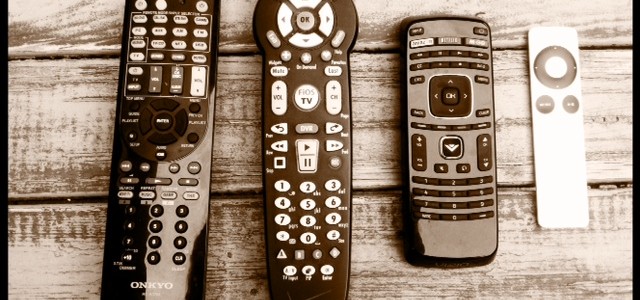You watch TV, right?
How many buttons do you figure you have on your remote control?
Say…about 50?
How many of those buttons do you actually use?
If you’re like me, you probably only use a handful of them (on/off, up/down, guide, exit, select, mute, volume up, volume down, channel up, channel down, and some of the number symbols for those times when I can actually remember the triple digit number of the channel I’m hoping to land on).
Actually, for full disclosure, it takes 3 remote controls to turn on our TV. That’s a lot of unused buttons!
Wait, why are we talking about remote controls?
Apart from the fact that I’m just crazy like that, I’m reading a book called Made to Stick: Why Some Ideas Survive and Others Die.
Chip and Dan Heath, the authors extraordinaire, are trying – quite successfully – to educate me on how to create lasting ideas in my quest for world domination.
I mean…what?
Ok – you got me! I’m trying to dominate the world, coaxing people to eat green vegetables, beets, and health foods for breakfast, lunch, and dinner.
(This coming from the kid who thought Fruit Loops and White Wonder Bread should be their own food groups. And ketchup. Definitely ketchup. And don’t get me started on Cadbury’s Caramilk bar.)
Wait, what’s that? You’re not convinced to swap out your morning sugar cereal for broccoli just yet?
Well that’s because Chip and Dan aren’t finished with me yet, of course (and when they are, hold onto your Lucky Charms, because I’m coming for them! I hear they’re magically delicious!).
But what they have gotten me to see is that not only do messages need to be simple yet effective, but so too does decision making. And it would seem, dear Watson, that their analogy with the remote control struck a chord with me where decisions are concerned.
Because, quite frankly, my own personal remote control – the one I use as a guide for my life – and more specifically, to make decisions – is easily about 100 buttons too full. And the worst part is that I’m trying to push all of them at the same time. So now my TV viewing experience is really screwed up! I’m surprised my TV even turns on at all (or that I can even walk in a straight line).
Making decisions is tough for me, which is why you may have noticed that I have added 17 new jobs to my LinkedIn profile in the last few weeks. I don’t want to choose: I want to do all of them! They all compliment each other really nicely, and I love doing all of them (are you shaking your head at me? Me too).
It’s just that, well, I’m having trouble fitting everything else into my life (surprised?).
As a result, I’ve just inhaled a pint of coconut chocolate peanut butter ice cream in an effort to soothe my inability to find more time. Time? I can’t buy. But ice cream? I can. And I can eat it too. All of it.
(You should know that the “ice cream” I speak of really wasn’t ice cream. I accidentally left the freezer door open last night – just a crack but enough to melt everything inside. Including the ice cream. So I effectively just had coconut chocolate peanut butter soup. More like inhaled. I inhaled coconut chocolate peanut butter soup. How you like me now?).
In contrast to the busy remote control I seem to have created that is my life, there is my Apple TV remote control. Glorious. Teeny tiny. And it only has 3 buttons on it. And yet with those 3 buttons (and a fun circle thingy), I can access Netflix, Apple TV, YouTube, and countless other entirely useful and often used applications on a daily basis.
Life: simplified. All for one easy payment of $99.99.
Applying this to my life, obviously, something has got to give. I have to start making some clear cut decisions as to where to spend my time. But it’s clear that I also need help making decisions in general. Simplifying my life will help me with that, for less noise will leave me with more room to think. Or rather, to just be.
According to business guru, Peter Drucker, “the most important part [of decision making] is to make sure that the decision is about the right problem. Few things can do as much damage as right decisions to wrong problems.”
Now back to our terrorizing remote control(s): With too many buttons, how are we supposed to navigate our way through to identifying the right decisions to the right problems in the first place? Aren’t the extra buttons just red herrings and cause for unnecessary complications?
Complicated is intimidating, and it causes paralysis. If we look at our lives and get overwhelmed, just as we do a TV remote control, we throw up our hands, walk away, and do nothing instead (my parents won’t even turn on my TV when they come to visit and I’m not home. Case in point.)
So it would seem that in order to make decisions, we need to turn to our Apple TV remote control: only 3 buttons (and that circle thingy), but with infinite possibilities, or rather, solutions.
According to Peter Drucker, there are 7 key elements to decision making:
1. Determine whether a decision is necessary.
2. Classify the problem.
3. Define the problem.
4. Decide on what is right.
5. Get others to buy the decision (where applicable).
6. Build action into the decision.
7. Test the decision against actual results.
It all seems so easy, but if we are to follow the example of Apple TV, which allows us infinite possibilities with only 3 buttons, there’s hope for the simple life.
If we only need a few buttons from which all of our decision making can come, here are 5 to consider adding to your remote control:
1. Use the force.
No, no. Don’t pull out your lightsaber. It’s cool, but save that for another day. I’m talking about your intuition. “I just have a bad feeling about that,” you’ve no doubt said to yourself a time or two. That’s your intuition talking, and I dare say it’s smarter than the noise that makes up your mind. So if your initial reaction to something is a resounding YES or NO, listen to it. Don’t question it. That’s the force. Don’t mess with it.
2. Understand that there is no right or wrong decision.
When Robert Frost met that fork in the road, he chose the one less traveled. But who’s to say that if he chose the one most traveled that his life wouldn’t have been just a great? No one. Because every choice leads to a different set of circumstances, and no choice will protect you from feeling pain and suffering, if not in the short run, then in the long run. It’s just part of life: where there is yin, there must be yang. So don’t think you can decide your way out of trouble indefinitely. Knowing that leaves you free to work on your mental fortitude in the face of adversity instead.
3. Choose based on your core values.
You need to identify your core values so you have a value system from which to make decisions. If you don’t know what you stand for, how are you supposed to choose a path? Your ship needs a captain, and you’re the natural choice for the job.
4. Know your mission statement.
Have you ever written a personal mission statement? Why not? Just like your core values, you need to know what’s important to you – and only you – in order to make the best decisions for your life. So write out your personal mission statement, and you just might find that your decision making takes a dramatic leap in the right direction. Need some help? Try this.
5. Pareto’s Principle: The 80/20 rule.
Come on – we couldn’t talk about decision making without bringing this up, could we? I think not. Pareto’s principle states that about 80% of effects come from only 20% of the causes. For example, in business, many companies note that 80% of their sales come from only 20% of their clients. With this in mind, identify your own 80/20 and make decisions from there.
BONUS: Learn how to say no.
Sometimes saying no means saying yes (no, I cannot bake that cake for you so that yes, I can get some much needed down time). Actually, anytime you say no to something, you are effectively saying yes to something else. And the reverse is also true: anytime you say yes to something, you effectively say no to something else. You will never win this game. You will never please everyone all of the time. So learn the strategy – your strategy – behind saying no.
Chip and Dan Heath said it best when they said, “When your remote control has fifty buttons, you can’t change the channel anymore.” And where decision making is concerned, it would seem that overly complicated lives make decision making harder than it needs to be.
The take away? When it comes to making decisions, less is more. So make like Apple TV and think different.
Your crazy friend,
Lauren
xxx
For the two books I referenced, see:
and











Lelio Vieira Carneiro Junior
July 31st, 2017 15:57
Fantastic site you have here but I was curious if you knew of any message boards that cover the same topics talked about in this article? I'd really love to be a part of community where I can get feed-back from other knowledgeable individuals that share the same interest. If you have any suggestions, please let me know. Kudos!
Lelio Vieira Carneiro
July 31st, 2017 16:04
Good day! I know this is somewhat off topic but I was wondering which blog platform are you using for this site? I'm getting tired of Wordpress because I've had issues with hackers and I'm looking at options for another platform. I would be awesome if you could point me in the direction of a good platform.